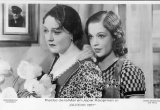Publicity in the 1930s
‘Cinematography is young; publicity is even younger’, quipped publicity manager Henrik Scholte in his contribution to the jubilee issue of the ‘Officieel Orgaan van den Nederlandschen Bioscoop-Bond’ that was published on 11 February 1938 on the occasion of the 20th anniversary of the founding of this organization.
‘It used to be simply about foreign templates, clumsily assembled newspaper ads, accompanied by a little tiny review, tucked away in the paper and usually so neutral that it neither harmed nor helped the film, and unattractive decorations that only stood out because of their garish colours. And when no expense was to be spared for a film: a pair of sandwich men, a pony wagon with a litho, usually in another language. And then, the more or less successful street ballyhoo which, as a topic of conversation, was supposed to help the film by word of mouth’, Scholte wrote.
Powers of persuasion
From this, however, one shouldn’t conclude that contemporary film publicity had gotten ‘calmer’, according to Scholte. One’s suitability or not as a publicity manager had to do with one’s ‘eccentricities’. He should, however, refrain from ‘circuslike or offensive clowning around’ that had sometimes taken place in the past. For example, he should take into consideration that ‘the Dutchman always considers if he should be annoyed before he starts to laugh’.
In addition, one should remember the tie-in ‘by which the publicity manager could demonstrate his ‘inventiveness, adaptability and powers of persuasion’. These were collaborations between big firms, warehouses, shops or associations in which the interests of the film company or the cinema where the film was shown were joined with those of another organisation. Large Dutch companies such as KLM, Philips and a few warehouses that already had their own ‘publicity department’ acted as good examples by entering into this sort of joint venture.
Free publicity
Another useful publicity vehicle was the press. Scholte, however, believed that there were hardly any film journalists, in the true sense of the word. Film journalism at the time, in his opinion, was primarily a leisure activity pursued by music critics, men of letters or local reporters who were ‘keen on free tickets’.
Comparatively speaking, this last group was the best for business because at least they knew who the ‘audience’ was, whereas ‘art reporters’ were all too often ‘individualists’ whose only perspective was a ‘personal reckoning’ with the film. In addition to regular notices, Scholte considered advertisements to be another important part of the press.
On the air
Besides this, Scholte thought radio was an excellent medium for publicity. In the United States, after all, the realisation was dawning that ‘after all the boisterous delight of ballyhoo publicity’, the newspaper and radio were ‘the only two safe methods’ to publicise a film.
Compared with the US, however, the Netherlands was in a peculiar position, according to Scholte. Broadcasting in the Netherlands was non-commercial and was supervised by the government, whereby ‘advertisement’ had somewhat of a bad name.Nevertheless, Scholte was convinced that ‘appropriately edited music, radio plays and film talks’ heard on the airwaves at that time had already done ‘a massive amount for film publicity’.
This means of communication – the radio and the broadcaster’s voice – had a great and untapped future potential, as long as bad publicity didn’t cut the ground out from under the feet of this sort of good attempts.
Traditional means
As far as usual smaller scale methods such as folders, posters and handbills were concerned, the Dutch ran into the following handicaps: ‘a limited area for distribution, choice of talent and even more limited financial means’, and Scholte found that because of these factors, publicity tools such as these didn’t always deliver the desired result.
Above all, making this sort of advertisement material was relatively expensive, in his opinion, which meant that not every cinema owner would be quick to spend such high sums. Another handicap was that this kind of promotional material was usually made for distribution throughout the whole country, which resulted in the big cities having to suffer what was ‘currently in fashion in the provinces’. And since as audiences, in part due to the dire financial times, had become more choosy in ten years’ time, the film publicity in the Netherlands should focus more on quality and continuity.
Cinema owners and publicity managers should understand all types of film in order to advertise them appropriately. Every film had its own unique ‘selling points’, after all.
more information
If you are looking for more material from our collection, please contact Film Sales:
sales@eyefilm.nl
phone +31 (0)20 5891 426


